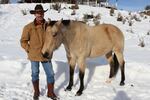
Debbie Johnson brought her kids to the occupied refuge in part to assure them that they need not be afraid.
Amanda Peacher / OPB
Surrounded by her five children, rancher Debbie Johnson walked through the occupied Malheur Wildlife Refuge headquarters Tuesday, talking with the militants who want an end to federal management of public lands.
"I brought my kids down because I didn't believe that it was something to be feared in our community, and so far I've very been impressed with how welcoming these guys are — shaking our hands and answering all of our questions," said Johnson. Johnson and her husband, Rodney, own a small ranch in Harney County.
The occupation of the Malheur National Wildlife Refuge in southeast Oregon has focused attention on management of public lands. The ranchers of Harney County, Oregon, have a long history of working — and struggling with — agencies such as the Bureau of Land Management.
Johnson is undecided if the militants' approach is a good thing. But she appreciates that they're shining light on a long history of conflict and some ranchers' frustrations.
Ranchers who graze cows on public lands are required to meet rules designed to protect resources like water quality, fish and wildlife habitat.
Related: Controversial Federal Grazing Fees Not A Great Deal For Anyone
The BLM regulates the number of cows allowed in an area, how much they can graze, how many cows can be clustered around a stream.
"Every year it seems to get a little bit harder. Another regulation, another rule. The red tape is unbelievable," said Johnson. "We definitely feel like it's only a matter of time before they shut our lands down and they shut us out of it."
Republican Congressman Greg Walden shares some of those feelings. His sprawling Oregon district includes the occupied refuge. On the House floor this week, Walden said he doesn't condone the occupation, but he understands the militants' frustration.
"This is a government that has gone too far for too long," Walden said.
Walden spoke about what he called the "arrogance of bureaucrats" in interpreting laws.
"Do you understand how frustrated I am at this? Can you imagine how the people on the ground feel?"
'I'm not going to let some other people be my face.'
Not all in Harney County have an antagonistic view of land managers. In fact, many ranchers say the relationship with agencies has strengthened over the years.
Georgia Marshall is a Harney County rancher of 64 years who says she has grazing permits on both BLM and Malheur Wildife Refuge lands. Speaking at community meeting in Burns Wednesday, she encouraged community members not to reignite the grudges of the past between ranchers and federal agencies, pointing to the collaborative work of the High Desert Partnership.
"You may not know a lot about it, but it's working damn hard for us," said Marshall, passionately. "I have seen the progress that we have made in this community compared to the s--- we went through years ago. Granted, it's not a lot of progress. But it's coming," said Marshall.
The High Desert Partnership is a well-respected local nonprofit that brings ranching, government, conservation and other interests together for collaborative decision-making and projects. It was founded in part to change the antagonistic tone between land users and agencies in Harney County. And Marshall said the collaboration has made big strides.
"Let's not destroy what we're doing because we think we have to make a stand for everything that's happened in the goddamned past," Marshall said at the meeting. "We don't know our future. But I'll tell you what — it's better than what we had. I'm pissed as hell right now. And my boots are shaking. But I'm not going to let some other people be my face. I am me. This is my home," said Marshall.

Tom Sharp with his horse, "Buck" at his ranch outside of Burns.
Amanda Peacher / OPB
Rancher Tom Sharp also said occupiers of the refuge don't speak for him.
Sharp's ranch is a remote, snow-covered expanse of sagebrush and juniper. About a dozen pregnant cows lumber toward a stack of hay. His three horses "Buck," "Ada" and "Star" stand watch under a juniper tree.
"Still the best way to get around on your property and check things is on horseback," said Sharp. He has off highway vehicles, too. But riding "Buck" puts his cows at ease, and allows him to "become one of them," he said.
Sharp grazes his cattle on about 1,000 acres of private land. But as a leader Oregon Cattlemen's Association, he also works closely with ranchers who lease grazing permits from the BLM. He says that policies written in Washington D.C. don't always work for rural Oregon.
"There will always I think be a certain amount of tension between the rural communities and the rancher and any federal agency like that," Sharp said. "I think what is important is that how you resolve those issues when they occur."
Sharp said, take for example, a threatened bird. One of those collaboration with the BLM involved protecting the greater sage grouse. He and other ranchers wanted to prove that they could conserve the grouse without an Endangered Species Act listing.
"I wanted to protect and do things right in conservation actions to protect the species so that restrictions wouldn't be applied to my operation," Sharp said.

Tom Sharp worked with agencies and local groups to create conservation agreements to protect the greater sage grouse.
Amanda Peacher / OPB
He helped lead the effort to craft Candidate Conservation Agreements between landowners, local agencies and the U.S. Fish and Wildlife Service. Through the agreements, landowners pledged to educe threats to the sage grouse by removing invasive species, nesting grounds and modifying fences so the birds would be less likely to collide with a fence while flying.
In exchange, landowners received assurances that they wouldn't be required to take more action to protect the grouse, should the bird be listed.
He thinks the collaborative plan crafted by ranchers, the local BLM and conservationists works well. And he thinks federal agencies usually do a good job with things like wildfire suppression and efforts to reduce invasive species. Harney County includes more than 70 percent federal land, and he says he can't imagine local residents having the bandwidth to manage all those acres.
"It would be difficult for the state or for the county just to simply to take back from the federal government all of this land mass area that we have and manage it as well as the BLM," Sharp said.
But Sharp says if anything good can come of the Malheur refuge occupation, he hopes it's that more people understand the nuances and challenges in the rural west.
Debbie Johnson said people in cities may not understand what it's like to be a cowboy.
"It is the dirtiest, nastiest job you've ever done in your life. Come snow or sleet or hail or rain it doesn't matter, they're out there feeding the cows, pampering them — seven days a week," said Johnson.